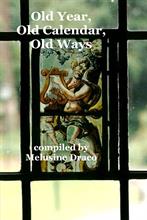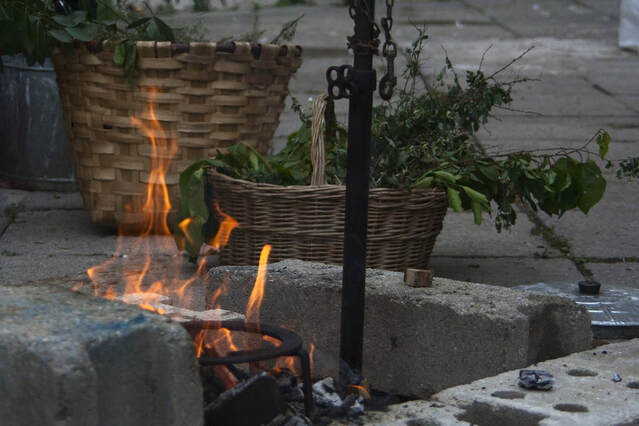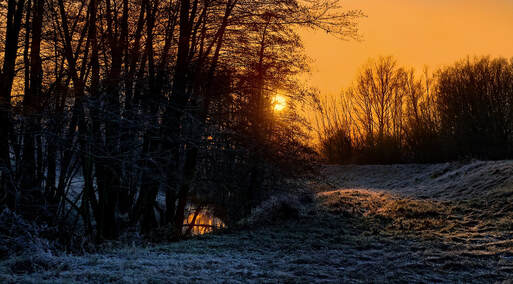
Fall and autumn are both accepted and widely used terms for the season that comes between summer and winter. Some who consider British English the only true English regard fall as an American barbarism, but this attitude is not well founded. Fall is in fact an old term for the season, originating in English in the 16th century or earlier. It was originally short for fall of the year or fall of the leaf, but it commonly took the one-word form by the 17th century, long before the development of American English. So while the term is now widely used in the US, it is not exclusively American, nor is it American in origin.
Autumn came to English from the French automne in the 15th or 16th century, but it didn’t gain prominence until the 18th century. After that, while fall became the preferred term in the US, autumn became so prevalent in British English that fall as a term for the season was eventually considered archaic. This has changed, however, as fall has been gaining ground in British publications for some time. [Grammarist]
SEPTEMBER: [OE] Hālig-mōnaþ ‘Holy Month’, when celebrations and religious festivals would be held to celebrate a successful summer crop. [OHG] Witu-mānod ‘wood month’. The Anglo-Saxons called it Gerstmonath or Barley-month with reference to the harvest of that crop, the main ingredient of the favourite alcoholic beverage. In the 14th century misericord calendar, it was shown as the time for cutting the corn for malting, i.e. beer making. The tree representing September is the Apple, one of the sacred trees that possesses magical powers.
Apple Magic: The folklore associated with apples appears mostly to do with determining romantic outcomes and finding a marriage partner. The apple has always been regarded as a holy tree and since earliest times it has been considered very unlucky to destroy apple trees or an orchard. On the opposite side of the coin, it was said to bring luck to the household if several apples were left on the ground after the harvest to keep the Faere Folk happy since apple orchards have long been regarded as places where the realms of the Faere Folk meet the mundane world. While mistletoe being the ‘golden bough’ and although more traditionally associated with oak trees, it is more commonly found on apple trees. The apple was one of the seven Chieftain trees and under Brehon law, the unlawful cutting down of an apple tree had to be paid for with a life. [Traditional Witchcraft for Fields & Hedgerows]
1st St Giles’ Fair at Oxford was originally a parish wake, a celebration of the local patron saint that, like a fair, was a festive occasion combining business and pleasure. The fair is held on the Monday and Tuesday following the first Sunday after St Giles’ Day but unlike a fair, a wake had no royal charter offering legal protection. Oxford had two medieval charter fairs, one held by the priory of St Frideswide from the 12th century in July near what is now Christ Church; and a May Fair founded in the 15th century, located where Wadham is today. The charter fairs gradually declined in importance, while the previously modest St Giles event flourished from the late 18th century onwards.
Weather-lore: ‘Fair on September 1st, fair for the month.’
4th The Abbots Bromley Horn Dance [Staffordshire] is an English folk dance dating back to the Middle Ages and has been described as ‘possibly the oldest surviving ceremony in Britain’.
It is know that the dance was performed at the ‘Barthelmy Fair’ in August 1226, however the reindeer antlers that give the dance its name suggest a much earlier origin, possibly a Druidic or Viking rite. A carbon-dated fragment of horn revealed a date of 1065±80 years. Today the Horn Dance takes place annually on Wakes Monday. After collecting the horns from the church at 8 o’clock in the morning, the Horn Dancers, comprising six Deer-men, a Fool, a Hobby Horse, a Bowman and Maid Marian, perform their dance to music at various locations around the village and surrounding countryside. By the time they return to the village green that evening, the Horn Dancers will have walked and danced over ten miles.
6th Sailing of the Mayflower. Anniversary of the day the Mayflower , a ship of 180 tons, finally set sail (1620) from Plymouth and conveyed to Massachusetts in North America, 102 Puritans, called ‘the Pilgrim Fathers’. They arrived at Cape Cod on 9th November, after a 66 day voyage. The event that Americans commonly call the ‘First Thanksgiving’ was celebrated by the Pilgrims after their first harvest in the New World in October 1621.
8th Little Walsingham Charter Fair of the Nativity of Mary. [Norfolk] The charter was granted by Henry III to the Prior and Convent of Walsingham and in return the Prior and Convent was to provide a wax candle weighing two pounds continually burning before the great altar of the church of St Mary, Walsingham. Today, there are circular wells and a square stone bath near an isolated remnant of a Norman archway in the priory ruins, which are noted nowadays for being ‘wishing wells’. Superstition says that if the visitor remains totally silent within about ten feet of the water, they should kneel first at one well, then at the other, and make a wish as they drink – but tell no one what you wish for. Committing one error in the ritual is said to be fatal. Another version mentions a stone between the wells on which one must kneel with their right knee bare, then put one hand in each well up to the wrist, and drink as much of the water as you can hold in your palms. Provided your wishes are never spoken aloud, they will be fulfilled within the year. Try bending the knee to the old gods and asking them for their blessings! Today: Make your own pilgrimage to these sacred springs from our pagan past.
14th Stourbridge Fair. In 1199, King John granted the Leper Chapel at Steresbrigge in Cambridge dispensation to hold a three-day fair to raise money to support the lepers. The first such fair was held in 1211 around the Feast of the Holy Cross (14th September) on the open land of Stourbridge Common alongside the River Cam. Stourbridge Fair continued until it was held for the final time in 1933. Today: The fair was revived in the 21st century and celebrated its fifth anniversary in 2008, so it makes an ideal day out for the family.
14th Holy Rood Day and traditionally the day on which children and young people were freed from school or work to gather nuts. This was a significant medieval holiday when tradition dictated that you went nut gathering. In most cases this meant gathering hazel nuts which were an important protein source in the winter for people and animals, but could also be sold to dyers, the nuts making both red and black dye. People have been gathering hazel nuts in Britain since the dawn of time and in 1995 a shallow pit was discovered on the island of Colonsay in the Inner Hebrides, it was full of the remains of hundreds of thousands of burned hazelnut shells which were carbon dated to about 7000 BC. Today: Hazelnuts collected on this day have magical properties - double nuts (two on a stalk) ward off rheumatism, toothache and the spells of witches. But don’t gather them if they’re unripe - the hazel is a powerful tree (the tree of wisdom, some say) and gathering unripe nuts can be dangerous.
20th Mercantus, another Roman four-day celebration of markets and fairs, which coincided with …
20th Old Barnstable Fair, whose charter dates from the early Middle Ages is held on the Wednesday before 20th September and was one of the most important fairs in Devon. The opening is heralded by a ceremony at the Guildhall, where spiced ale brewed from a closely guarded Elizabethan recipe is ladled into silver cups from which all present must drink to the success of the fair. A large white glove is carried? from the building – an ancient symbol once used to show that outsiders could enter and trade freely in the town. A similar custom applies to the fair held at Honiton on the last Tuesday in July. Today: If you’re in the area make a point of going to the new Barnstable Country Fair
21st The Autumnal Equinox and Feast day of the pre- Celtic god of regeneration, Bran Fendigaid, or Bran the Blessed. Check on the Internet for the correct alignments. This is one of the most important and holiest times in the pagan calendar and a start of the celebrations of the harvest. The Harvest Moon is the full nearest the autumnal equinox and a peculiarity is that it rises for several days near to sunset and at about the same time; the Hunter’s Moon is the full moon following the Harvest Moon because hunting does not begin until after harvest.
21st The holiday of the Autumnal Equinox, Harvest Home, Mabon, the Feast of the In-gathering, Meán Fómhair or Alban Elfed (in Neo-Druid traditions), is a pagan ritual of thanksgiving for the fruits of the earth and a recognition of the need to share them to secure the blessings of the Goddess and the God during the coming winter months. The name Mabon was coined by Aidan Kelly and incorporated into the Wiccan Wheel of the Year around 1970 as a reference to Mabon ap Modron, a character from Welsh mythology. Among the sabbats, it is the second of the three pagan harvest festivals, preceded by Lammas/Lughnasadh and followed by Samhain.
21st Feast of Mabon ap Modron. In Welsh mythology he was the ‘great son’ of the mother-goddess and the god of youth known from the Mabinogion and later Arthurian romances. It is the time of the end of the harvest and emphasises the importance of remembering the old customs.
24th Harvest Festival. Traditionally the day on which harvesting began in medieval England. Today: Arrange your own harvest supper around the kitchen table.
26th Feast Day of St Cyprian: The patron of sorcerers who served the Old Gods, despite being named a Christian saint. The Book of Saint Cyprian (Portuguese: Livro de São Cipriano; Spanish: Libro de San Cipriano) refers to different grimoires from the 17th, 18th, and 19th centuries, all falsely attributed to the third century magician. According to popular legend, Cyprian of Antioch was a pagan sorcerer who had converted to Christianity. Similarly, according to legend, King Solomon was not only the wisest man in the land but he also had magical abilities and by the Renaissance, a number of magical texts (called grimoires) were penned in his name. Today: A good opportunity to raise a toast to magic!
29th Michaelmas – also known as the Feast of Saints Michael, Gabriel, Uriel and Raphael, the Feast of the Archangels, or the Feast of Saint Michael and All Angels, is a minor Christian festival observed in some Western liturgical calendars. Widely popular in the Middle Ages Michaelmas differs from the other saints’ days in that it honours a spirit and not a human being. Michaelmas is one of the four quarter-days of the financial year and probably more superstitions surround the day than any other in the calendar. Today: Why not celebrate traditionally by having roast goose and share with family and friends.
Weather-lore: ‘If St. Michael’s brings many acorns, Christmas will cover the fields with snow’.




 RSS Feed
RSS Feed